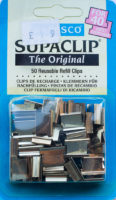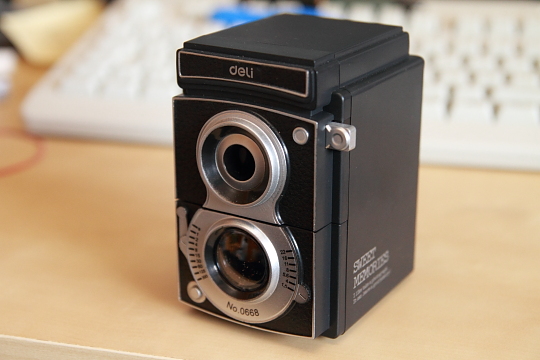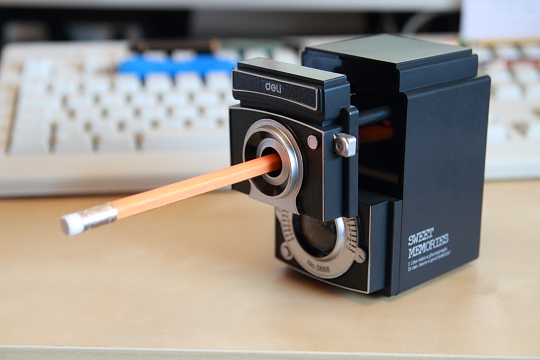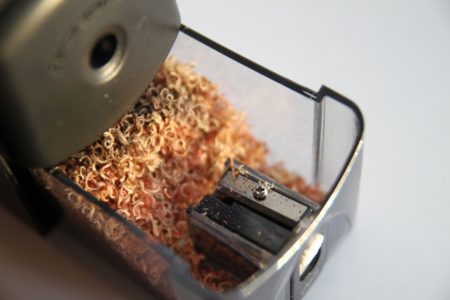Clam clips
Today I want to show you a type of clip that I use often and that’s very practical. Like the Ohto (officially OHTO) super clip and the corner clips, this type of clip is not very popular and this time I’m not even sure what to call this clip – there are so many different names for this type of clip. A few of the common names are: clam clip, supaclip, power clip, gachuck and nalclip.


(© Yoyo)
Function [1]This is gone be complicated, it’s probably easier if you just look at the pictures.
We are basically talking about a foldback clip (also called foldover clip or binder clip – here in the UK often called a bulldog clip) without the wire handle. This makes the whole clip quite a bit smaller as you leave out the two handles to open the clip which also means that the clip doesn’t need the small loops necessary for the handles. The disadvantage: you can’t easily open the clip any more when you want to clip it into paper, unless you have a clipper/dispenser, the device necessary to clip these clam clips onto the paper. Removing these clips is generally possible by pulling the clip off, most dispensers have a lip at the base to make pulling clips off easier. Even though you can remove them easily enough they clip the paper well enough so that the clip won’t come off by itself.
Ohto calls their version of this device Gachuck …because of the sound the dispenser makes when clipping paper together. I think in their version of the story the Gachuck’s inventor, a Mr. Sato, tried to approach several companies, but none were interested in this clipping system, until in 1980 he approached OHTO, back then still called AUTO, which then took on this product. Other companies have registered their names for these clips, too. Rapesco’s Supaclip even came with the tag line “The Original”.
Different versions

There are many different versions of the clipper/dispenser and of the clips – made by many different manufacturers. I know of four different types of clippers and have three of the four different types. You can find each of these different types of clippers from different manufacturers and in different sizes. Clips are available in different widths as well as with different thickness to handle more sheets if needed.
Most clippers will only handle one size of clips, but will usually be able to handle clips made from different material. Most clips are made from stainless steel, but there are also plastic clips and clips made from a paper and polypropylene mix.
– Slot loading version

The most common version these days seems to be the slot loading version [2]This is just my name for this type. If you know what this and other versions are officially called, please let me know.. You load the clips by feeding them into the slot at the back of the clipper. The slider, used to dispense the clips, is connected to a spring. It will automatically slide back after dispensing a clip, so you can use it again immediately. You will have to hold the clipper front down to get the next clip to slide to the front of the dispensing mechanism as clips will slide around in the dispenser, especially if the dispenser is nearly empty. The biggest disadvantage of the slot loading version: if a clip gets stuck you usually can’t remove it without inadvertently breaking the plastic off that prevents clips in the dispenser from falling out.
– Spring loaded version
This is my favourite version, unfortunately this version seems to be pretty hard to find these days. The advantage over the common slot loading version: the slider will slide back after use and will stop just after the next clip to be dispensed.

This means you can keep using the machine without having to turn it front down to get the next clip to the front. This is achieved using a spring mechanism similar to the one you will find in some good staplers [3]My Leitz stapler has a very similar mechanism. The disadvantage: you need to open the clipper, similar to a stapler, to reload it. This takes slightly longer than reloading the slot loading version.

– Springless version
This version doesn’t have any spring. This means that additionally to holding the clipper front down, to get the clip in the right position to be dispensed, you also need to use your thumb to move the slider to the back, to be in the right position to dispense the clip.

This is the least comfortable to use version, but fixing any stuck clips is much easier compared to the spring loaded version. It can usually be done without damaging the clipper.
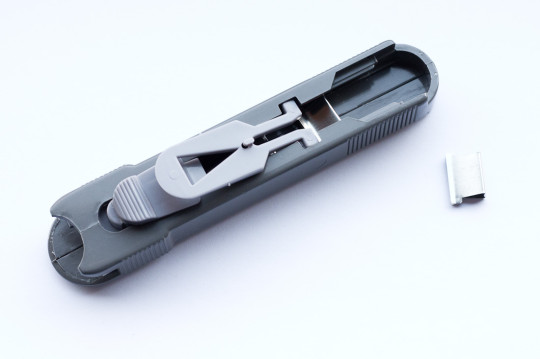
– Cartridge fed version
I don’t own a cartridge fed version, but as the name suggests you load the clipper by inserting a cartridge with clips. You can see a photo of this version on Ohto’s web site.
Usage
I like these clam clips a lot. I often use them to temporarily clip sheets of paper together that will get properly stapled at a later stage. If you have a dispenser at hand these clam clips are faster to use and more convenient that foldback clips.
Most of my clippers and clips were bought in Shanghai were a clipper or a pack of clips usually costs around 5-10 RMB (~80c – $1.50; ~50p – £1; 60c – €1). They are sold under the following brands: Bona, Comix and Deli. I bought the springless clipper many years ago from Schreibwaren Jäcklein in Volkach. It’s from Yoyo, distributed my Metzger & Mendle [4]I’ve been meaning to reciew their inks for a few years now. I should definitely try to do that soon.. I think I paid just above €5 (~$7; £4) for it. Replacement clips were just above €3 (~$4). Replacement clips bought in the UK are similarly priced.
Has anyone seen the spring loaded version of the clipper? I’d like to get another one [5]The one in the pictures actually belongs to my wife, but I’ve used it almost exclusively for the last few years. – they are great and the one I’m using has never had any problems with clogging up, unlike the slot loading clippers I’ve used.

No proper dates this time as I’ve bought these items over many years. The exchange rates given in the text are also only a rough guideline, as I just want to illustrate what you can expect to pay if you’re after one of these clippers.
References
| ↑1 | This is gone be complicated, it’s probably easier if you just look at the pictures. |
|---|---|
| ↑2 | This is just my name for this type. If you know what this and other versions are officially called, please let me know. |
| ↑3 | My Leitz stapler has a very similar mechanism |
| ↑4 | I’ve been meaning to reciew their inks for a few years now. I should definitely try to do that soon. |
| ↑5 | The one in the pictures actually belongs to my wife, but I’ve used it almost exclusively for the last few years. |
